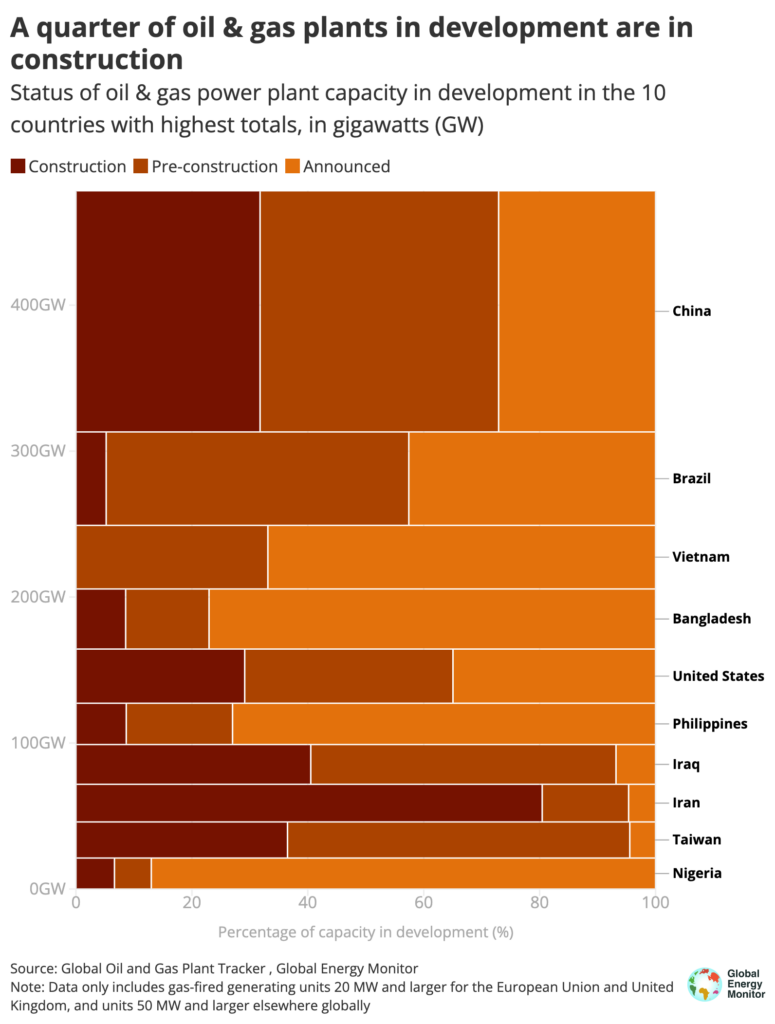Key points
- Global oil- and gas-fired power plants in development — projects that have been announced or are in the pre-construction and construction phases — increased 13% last year to 783 gigawatts (GW)
- Nearly two-thirds of this capacity and cost is in Asia, where 514 GW at an estimated US$385 billion are in development, mainly in China and Southeast Asia
- If built, the existing global oil and gas fleet would grow by a third at an estimated cost of US$611 billion in capital expenditure
San Francisco, U.S. – Driven by China and countries in Southeast Asia, global oil- and gas-fired capacity in development increased 13% last year, even as the region experienced volatile price swings and hosted some of the lowest costs for green electricity, finds a new report from Global Energy Monitor.
The Global Oil and Gas Plant Tracker catalogs nearly 12,000 units of every known oil- and gas-fired power plant in the world and shows that five countries — China, Brazil, Vietnam, Bangladesh, and the United States — make up almost half of all capacity in development.
Asia has nearly two-thirds of the world’s oil and gas plant capacity in development, with China hosting a fifth of the world’s in development capacity, more than the next three leading countries — Brazil, Vietnam, and Bangladesh – combined.
Construction began on 207 gigawatts of new oil- and gas-fired power plants, a 23% increase over the previous year. Almost three-quarters of this capacity is in Asia, mainly concentrated in China.While high LNG prices have pushed some countries in Asia, including Bangladesh and Pakistan, away from procuring LNG cargoes, analysts have also shown that the costs of electricity from solar and wind is on average below the cost of gas-fired power, and well below such cost in China.
Jenny Martos, project manager for the Global Oil and Gas Plant Tracker, said “Gas continues to grow even with its reputation unraveling as a cheaper, cleaner and reliable transition fuel. Price volatility has led many countries to turn their backs on gas plans. The severity of gas’ impact on the climate is better understood everyday because it leaks the potent greenhouse gas methane. And extreme weather events are causing fossil fuel power plants to fail. Still, the transition away from oil and gas is not happening anywhere near fast enough.”

Contacts
Jenny Martos, Project Manager, Global Oil and Gas Plant Tracker
Email: [email protected]
Julie Joly, Program Director, Oil and Gas
Email: [email protected]
About the Global Oil and Gas Plant Tracker (GOGPT)
The Global Oil and Gas Plant Tracker (GOGPT) is an online database that identifies and maps every known oil- and gas-fired generating unit and every new unit proposed since January 1, 2020 (20 MW and larger in the European Union and United Kingdom, 50 MW or larger elsewhere). Since August 2023, GOGPT includes exclusively oil-fired power plants and oil and gas units using internal combustion technology, also known as engines. Developed by Global Energy Monitor, the tracker uses footnoted wiki pages to document each plant and is updated biannually. For further details see the tracker landing page and methodology overview.
